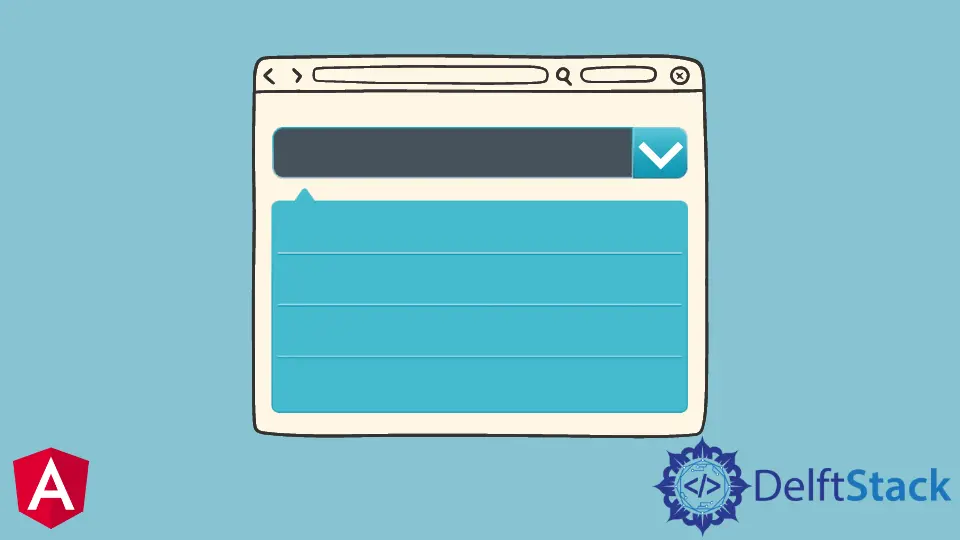How to Implement Drop Down Menu in AngularJS
- Basic HTML Syntax of a Dropdown Menu in AngularJS
-
Use
ng-optionsAttribute to Create a Dropdown Menu in AngularJS -
Use
ng-repeatAttribute to Create a Dropdown Menu in AngularJS -
Difference Between
ng-optionsandng-repeatAttribute in AngularJS - Conclusion

AngularJS is a JavaScript framework for building web applications. AngularJS provides data-binding and dependency injection, which reduces the need for manual code writing.
This article shows methods to create a dropdown menu with AngularJS. Let’s begin.
Basic HTML Syntax of a Dropdown Menu in AngularJS
Before we dive into the topic, let’s first understand the basic concept of the Dropdown box in Angular.
A dropdown list is a type of selection menu where the user can select one item from a list. It’s also known as a combo box or pull-down menu.
Mainly, the menu can be opened and closed by clicking on the title or > button. A select element or a list item is used to add a dropdown box to a website page. We must set the preferred option in the first <option> tag to the desired value in the selected element.
Let’s take a look at the basic HTML syntax.
<dropdown placeholder="Cars" list="Cars" selected="Black Car" property="Model"></dropdown>
The syntax above is an example of how we can use the dropdown. Before the user selects anything, the placeholder parameter specifies what text to display.
The Cars variable refers to a list of items you wish to appear in the list, and it’s used in combination with the property variable, which specifies which property from your complicated JavaScript list objects should be displayed to the user. Finally, the selected attribute saves the specified value on the parent controller.
In AngularJS, the ng-options attribute and the ng-repeat attribute are the two methods that are commonly used to create a dropdown menu.
Use ng-options Attribute to Create a Dropdown Menu in AngularJS
An ng-options directive is an AngularJS construct that creates a dropdown list with select options. This directive should only be used when the select control should be part of your page’s template.
The ng-options attribute has an opening and closing tag and an array of two or more objects representing the options for this particular option group.
Each object consists of two properties: the first is the text that will appear in the input field, and the second is an object with other parameters that control how this option behaves.
The example for this directive is as follows.
<div ng-app="demo" ng-controller="myCtrl">
<select ng-model="Options" ng-options="Names">
</select>
</div>
<script>
var app = angular.module('demo', []);
app.controller('myteam', function($scope) {
$scope.names = ["Dan", "John", "Smith"];
});
</script>
Limitations of Using ng-options to Create a Dropdown Menu in AngularJS
The ng-options attribute is an excellent directive for dynamic options lists in Angular. The ng-options attribute helps display an array of options in a select list. However, it does have some limitations.
One of the limitations is that ng-options are not compatible with other Angular components using the ng-repeat directive. If you want to use ng-repeat with another component, you must write your code to generate an item in your list.
This limitation can make your code difficult to maintain and understand if you don’t know what’s going on under the hood.
Use ng-repeat Attribute to Create a Dropdown Menu in AngularJS
An ng-repeat directive in AngularJS lets you repeat an HTML element for every object in the collection you are iterating over.
We can use the ng-repeat directive to create lists of items, for example, to populate a dropdown list. The ng-repeat directive loops through all specified array or object elements and creates more DOM elements for each found object depending on the HTML attribute used.
To learn more about the dropdown menu in Angular, click here.
The example for this directive is given below.
<div ng-app="Sample" ng-controller="Testing">
<select>
<option ng-repeat="Name">{{name}}</option>
</select>
</div>
<script>
var app = angular.module('Sample', []);
app.controller('Testing', function($scope) {
$scope.names = ["Rockstar", "Dan", "Patrick", "Han", "Jordan","John"];
});
</script>
Limitations of Using ng-repeat to Create a Dropdown Menu in AngularJS
- Only one variable can be used when defining the items in the list, and it must be an array or an object. It means that we can’t dynamically add and remove items in a loop, and we can’t pass any other data into
ng-repeat. - An index is generated automatically by AngularJS, which means that we don’t control what numbers get generated. To overcome this limitation, you must manually change the index number every time a new item is added or removed from the list.
Difference Between ng-options and ng-repeat Attribute in AngularJS
The ng-options directive displays a select box if the selected option is unavailable. It creates a list of all the possible values.
On the other hand, the ng-repeat directive creates an array of all the possible values to be chosen.
Moreover, dropdowns created with ng-options can have an object as the selected value, whereas dropdowns created with ng-repeat must have a string as the selected value.
Click here if you want to know more about ng-options and ng-repeat.
Conclusion
This article provides us with a lot of information about creating a dropdown menu in AngularJS. We learned to create a dropdown menu in AngularJS, implement them, and get started with them.
Click here to check the code mentioned above.
Muhammad Adil is a seasoned programmer and writer who has experience in various fields. He has been programming for over 5 years and have always loved the thrill of solving complex problems. He has skilled in PHP, Python, C++, Java, JavaScript, Ruby on Rails, AngularJS, ReactJS, HTML5 and CSS3. He enjoys putting his experience and knowledge into words.
Facebook